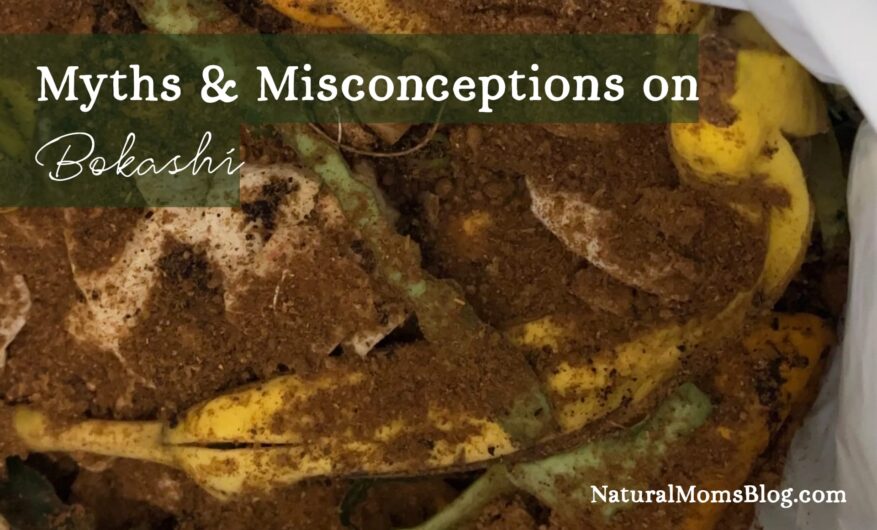- in Gardening by Alexis Rodrigo
Bokashi Composting Myths and Misconceptions

Update: I made a video based on this post. Let me know what you think in the comments.
I am a huge fan of Bokashi composting.
However, there’s too much hype about Bokashi composting. These misconceptions lead to people getting disappointed or, worse, believing they’ve failed at Bokashi composting.
In this post, I’d like to set some things straight about Bokashi. Below are some of the common myths and misconceptions about Bokashi composting — and the truth you should know.
Myth: Bokashi composting doesn’t smell.
Truth: Bokashi composting smells like fermented food.
Bokashi composting is a process of fermentation and not putrefaction or rotting, which is what takes place in traditional composting.
With Bokashi, you will not or should not have a smell of rotting food. But it does have a smell. It’s the smell of fermentation. It’s a slightly sweet, slightly sour smell. Think beer, cheese, and kimchi—all foods produced through fermentation.
Personally I don’t mind the smell of fermentation. But you might.
The longer you let the food waste ferment, the stronger its smell. I kept some Bokashi’d food waste in plastic bags inside a plastic container over the winter. I’m glad the container had a lid, because when I took them out in the Spring, the smell was strong. And, yes, it was almost offensive. Almost. It’s still not the smell of rotting flesh, but the smell was undeniable.
Myth: Bokashi gives you compost in two weeks.
Truth: The fastest you’ll have Bokashi-enriched soil is four weeks.
There isn’t a clear-cut answer as to how long it will take for you to have Bokashi compost. Here’s a breakdown of the process, along with the approximate or MINIMUM amount of time you’ll need for each step.
Collect food scraps in a Bokashi bucket – Varies depending on the size of your bucket and the amount of food waste you generate. For my family of five, it takes two-three weeks to complete this step.
Fermentation – 2 weeks
Decomposition in soil – 2 weeks
While Bokashi composting is faster than traditional pile or bin composting, it still takes time.
Myth: Bokashi gives you compost.
Truth: Bokashi produces enriched soil and, when mixed with soil, makes excellent compost.
In traditional composting, the waste materials turn into a dark, nutritious dirt called compost.
Bokashi doesn’t work exactly the same way. First, you end up with fermented food scraps. Then you bury the food scraps in the ground. In the beginning, this soil is quite acidic because of the Bokashi — too acidic to plant in (however you can plant seeds into this soil, because the roots wouldn’t reach the Bokashi waste right away).
But two weeks later, the soil over the Bokashi has neutralized. It is now ready to be planted in, and whatever you plant will get the extra nutrition and beneficial microorganisms from the Bokashi that was buried underneath.
But if you were to dig up this spot again, you would see that the Bokashi’d waste hasn’t completely broken down yet. In fact, much of it would probably still be intact. It would take at least a month before everything breaks down completely. (I’ve planted into soil with visible Bokashi-fermented food, and saw no ill effects on my plant. In fact, this plant grew very well)
To produce compost, you need to mix the Bokashi waste with soil and let it break down completely (see my Bokashi soil factory). Bokashi-fermented food alone will not turn into compost until it is mixed with soil. Alternatively, add your Bokashi waste into a traditional compost. The Bokashi’d waste will speed up the composting process.
Myth: You only need a handful of Bokashi bran for every 1/2 inch of food scraps.
Truth: It depends.
This is probably the minimum amount of Bokashi bran you’ll need to use. However, for best results, you’ll sometimes need to use more. For example, I use extra Bokashi bran whenever my food scraps contain:
- big pieces (I’m too lazy to slice into smaller pieces)
- animal bones
- wet scraps, such as tea bags and coffee filters
- citrus (they supposedly take a longer time to break down)
When it comes to Bokashi bran, the more you use, the better.
Myth: Bokashi is a method of indoor composting.
Truth: Normally, Bokashi composting takes place first indoors, then outdoors. However, you could do everything indoors or outdoors, depending on your circumstances and preferences.
Again reviewing the steps to Bokashi composting, you first collect your food waste in your Bokashi bucket and let it ferment for two weeks. This takes place indoors. In fact, it is not advisable to bring your bucket outside to ferment.
If you’d rather not have stuff fermenting inside your house or garage, you could try this method, in which Bokashi is buried and fermented straight in the ground.
The second part of Bokashi composting is to bury the fermented waste under the ground. Obviously, this takes place outdoors.But you could also move this process indoors by making Bokashi soil factories, instead (Read more about that here). My Bokashi soil factory is in the garage which, technically, is still indoors.
As you can see, Bokashi composting is not completely effortless. Neither is it free of smells and mess. But I hope you’ve come to realize just how easy, flexible, and DOABLE it is.
If you want to learn more about Bokashi composting, feel free to ask your questions in the comments below.
Ready to get started with Bokashi composting? Here’s the system I use and recommend:
If you liked this post, submit your email address below to get new posts by email:
